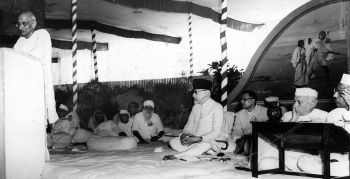The Madras Session of the Indian National Congress in 1927, held from December 26th to 28th, was a pivotal moment in the Indian independence movement. Here’s a comprehensive overview of what transpired:
Key Events:
- Presidency: The session was presided over by Dr. Mukhtar Ahmed Ansari, the President of the Muslim League. This marked a significant gesture of unity between the Congress and the Muslim League.
- Boycott of Simon Commission: The most crucial and defining resolution passed at the session was the call for the complete boycott of the Simon Commission. This seven-member British commission, consisting solely of Europeans, was appointed to study and recommend constitutional reforms for India. The Congress deemed the commission as unacceptable due to its lack of Indian representation and viewed it as an attempt to perpetuate British rule. The boycott strategy aimed to delegitimize the commission and exert pressure on the British government to grant India immediate dominion status.

- Demand for Purna Swaraj (Complete Independence): Another significant resolution at the session was the one for “Purna Swaraj,” or complete independence from British rule. This marked a shift in the Congress’s goal from dominion status to full autonomy. Jawaharlal Nehru played a key role in pushing for this resolution, marking his rising voice within the party.
- Other Resolutions: The session also adopted other resolutions condemning the use of Indian troops in foreign conflicts, supporting labor rights and promoting Khadi as a symbol of self-reliance and resistance against British economic domination.
Significance:
- The Madras Session marked a radical shift in the Indian independence movement. It signified a growing impatience with British rule and a demand for immediate and complete freedom.
- The boycott of the Simon Commission effectively exposed its undemocratic nature and garnered widespread support, leading to its ultimate failure.
- The demand for Purna Swaraj crystallized the ultimate goal of the freedom struggle and united different factions within the Congress under a shared objective.
- The session also strengthened the bond between the Congress and the Muslim League, highlighting the importance of Hindu-Muslim unity in the fight for independence.
Additional Information:
- The Madras Session saw the emergence of young and radical leaders like Jawaharlal Nehru, who advocated for more assertive tactics like mass disobedience.
- The decision to boycott the Simon Commission sparked nationwide protests and demonstrations, further unifying the public against British rule.
- The session’s resolutions set the stage for the Civil Disobedience Movement and other forms of active resistance in the years to come.
Understanding the broader context:
- The Madras Session occurred amidst growing discontent with the British Raj, fueled by factors like economic hardship, discriminatory policies, and the rise of nationalist ideas.
- The Simon Commission itself was a response to rising discontent but its composition sparked outrage and fueled nationalist sentiments.
I hope this information provides a comprehensive overview of the Madras Session of 1927. If you have any further questions or would like to delve deeper into specific aspects, feel free to ask!
